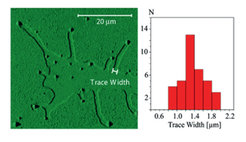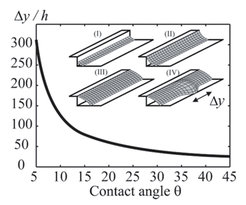Solid Interfaces
3.) Molecularly thin solid monolayer terraces of long chain alkanes melt with the appearance of (moving) liquid alkane drops at the terrace edges (liquid alkane wets neither its own solid nor the substrate). Amazingly, the drops (Fig. 3a) are magnitudes larger than the terrace height. A “text-book” melting/nucleation scenario does not explain this finding because it predicts a continuously growing, stable liquid channel at the terrace edge as the temperature rises (I → III, Fig. 3b). Eventually the entire channel disconnects at the terrace edge and rapidly melts “into” the solid. Instead, we postulate the fluctuation-driven formation of liquid bulges/drops (Fig. 3b, IV) before the entire channel becomes unstable. This explains the observed large drop sizes. More important, we introduce a new nucleation pathway via a morphological transition. It has a lower nucleation barrier and should be relevant for numerous ubiquitous systems (capillary condensation in scratches, etc).





